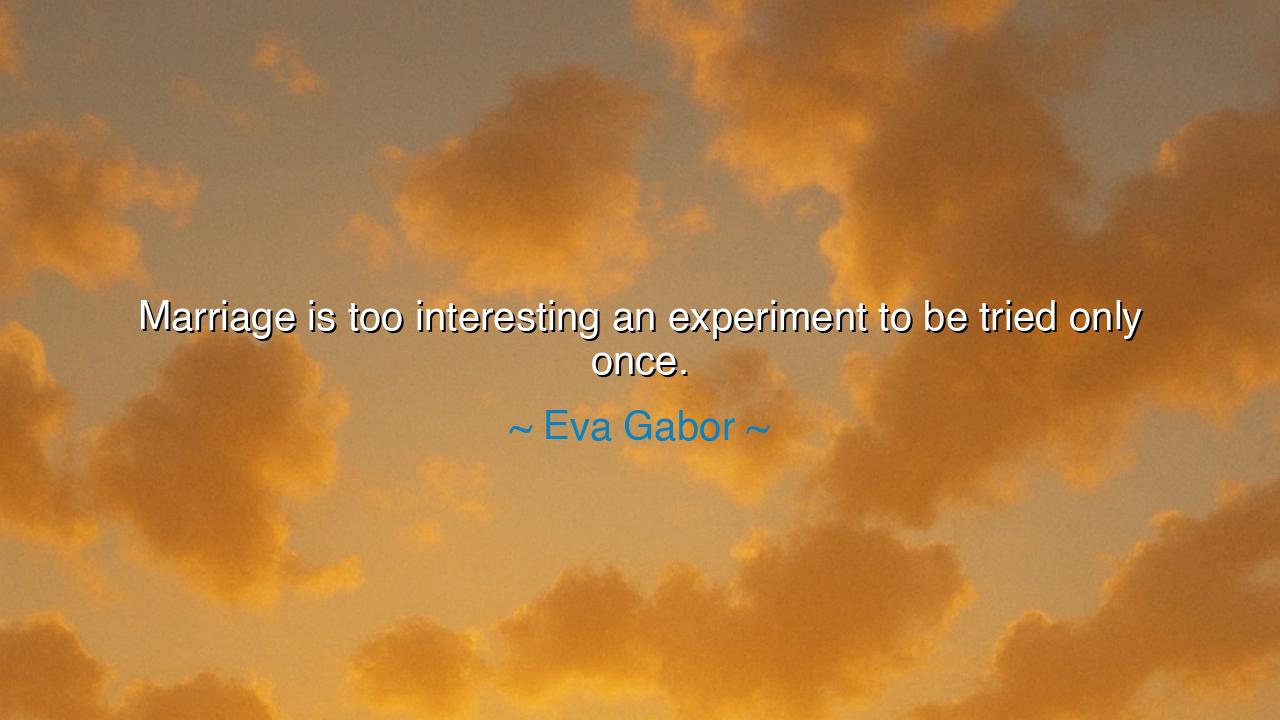
Marriage is too interesting an experiment to be tried only once.






In the grand tapestry of human existence, few unions are as profound, as transformative, as the bond of marriage. It is the thread that weaves two souls together, a journey of discovery, growth, and sometimes, inevitable change. Eva Gabor, with her playful yet insightful words, invites us to reconsider the sacred institution of marriage. She tells us, "Marriage is too interesting an experiment to be tried only once." There is a depth to her statement, one that speaks to the essence of human connection and the complexity of the emotional landscape we navigate when we choose to bind our lives to another.
From the dawn of civilization, marriage has been regarded as the bedrock upon which societies are built. In the ancient world, it was not merely a romantic union, but a sacred contract, binding individuals to their community, their land, and each other. In Greece, the marriage between Socrates and Xanthippe is a celebrated example, though their union was not without its struggles. Socrates, the great philosopher, often found himself in conflict with his wife’s temper and relentless demands, yet he remained committed to the union, seeing in it an opportunity for growth and understanding. Theirs was a partnership that transcended the superficial trials of marriage, evolving over time as both individuals adapted and changed. Their story speaks to the very idea that marriage, as Gabor suggests, is an experiment, one that requires multiple layers of effort, patience, and transformation.
Throughout history, the concept of marriage as an experiment, a dynamic and ever-evolving bond, has been exemplified by those who have dared to enter it multiple times. King Henry VIII of England, though a controversial figure, provides an example of how marriage can be seen not as a static institution, but one that unfolds with the passage of time. His six marriages were driven by his personal search for meaning, companionship, and ultimately, the desire for an heir. His successive marriages, though fraught with tragedy and political intrigue, highlight a profound truth: marriage is indeed an experiment, a process of discovery that may need to be revisited when the first attempt does not yield the desired results. While Henry’s story is marked by turmoil, it also underscores the human desire to continually seek and redefine love and partnership.
In the more modern world, Gabor’s words resonate deeply. Marriage, as an experiment, implies that it is not merely a final destination but a journey, one that may take different forms for different people. Elizabeth Taylor, whose numerous marriages captivated the public eye, embodies the notion of marriage as a series of evolving experiences. She entered into marriage not once, but many times, each time seeking new understanding, deeper connections, and often, new challenges. Though her unions were frequently scrutinized, Taylor’s willingness to embrace love in its many forms speaks to the understanding that marriage is not a rigid contract but a living, breathing connection between individuals that can adapt, change, and even end—only to begin again.
Gabor’s statement, while playful, carries profound wisdom. Marriage is not simply a trial run, nor is it a one-time attempt to create happiness. It is an ongoing experiment, a series of tests and discoveries that require continual effort, honesty, and evolution. Just as an artist returns to their canvas time and again, refining and adjusting their vision, so too must the married couple return to their relationship, each time with new insights and perspectives. True growth in a marriage comes from the ability to embrace its imperfections and challenges, recognizing that the bond between two people is not a product of perfection but of shared effort, compromise, and understanding.
The lesson we learn from Eva Gabor is simple yet profound: marriage should not be approached with the mindset that it is a singular event, a one-time decision that must last without evolution. Instead, we must understand that love and partnership are ongoing experiments—ones that demand patience, communication, and an openness to change. As we embark on the journey of marriage, we must accept that its beauty lies in its dynamic nature, in the willingness to adapt, to learn from each other, and to allow our bonds to deepen through both trial and triumph.
In our own lives, let us approach marriage with an open heart and a clear mind. Let us recognize that it is not a static state, but a continuous dance of discovery, growth, and resilience. And for those who may have found that their first attempt at this union has not worked as they hoped, let them remember Gabor’s words: marriage is too interesting an experiment to be dismissed at the first failure. Each attempt offers new lessons, new insights, and the possibility of a richer, fuller experience. In embracing this, we open ourselves to the true potential of love—a love that evolves, that deepens, and that endures, not because it is perfect, but because it is always growing.






AAdministratorAdministrator
Welcome, honored guests. Please leave a comment, we will respond soon